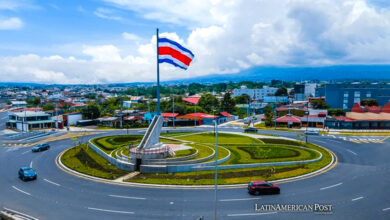Brazil’s Central Bank Lowers Interest Rates: Balancing Inflation and Growth
The Central Bank of Brazil has announced a significant reduction in its primary interest rate by 0.50 percentage points, now at an annual 12.25%, marking the lowest level in 16 months. This move reflects a complex interplay between curbing inflation and stimulating economic growth in Latin America's largest economy.

Photo: Roberto Campos Neto
The Latin American Post Staff
Escucha este artículo
Leer en español: El Banco Central de Brasil reduce las tasas de interés: equilibrando la inflación y el crecimiento
Navigating Economic Challenges
In a strategic financial move, the Central Bank of Brazil has reduced its benchmark interest rate by 0.50 percentage points to 12.25% per annum. This recent adjustment, the third consecutive cut and matching the mid-September reduction, signals a nuanced approach to steering the nation's economic course amid global and domestic challenges.
Under the presidency of Luiz Inácio Lula da Silva, inaugurated in January of this year, the Brazilian government has faced mounting pressure to reduce interest rates. These calls aim to alleviate the financial burden on the economy and foster growth. President Silva, known for his assertive economic strategies, has prioritized lowering interest rates as a key policy objective.
Central Bank's Cautious Approach
Despite these government pressures, the Central Bank, an autonomous entity currently headed by economist Roberto Campos Neto (appointed by former President Jair Bolsonaro), cautiously embarked on a gradual reduction of interest rates starting in August. The Central Bank's conservative stance stemmed from a primary concern for inflation control, often citing the need to balance economic growth with inflationary pressures.
Yet, Silva's administration argues that the interest rates remained unjustifiably high, considering the recent fall in the country's inflation to its lowest in years. The administration contends that elevated interest rates hinder Brazil's economic expansion and consumer spending.
Forecasted Trends and Ongoing Contractionary Measures
The primary interest rate in Brazil, known as Selic, stood at 13.75% annually, the highest since November 2016, until the reductions began in August. The recent decision to cut the rates was unanimously agreed upon by the members of the Monetary Policy Committee (Copom) of the Central Bank. They reasoned that while Brazil's economy is growing, a slowdown is anticipated in the coming months.
In a statement from the Central Bank, the directors noted that if the forecasted economic conditions hold, similar reductions in the interest rate might be expected in future meetings. They believe this approach is appropriate to maintain the necessary contractionary monetary policy, aiding in the ongoing process of curbing inflation.
Managing Inflation Projections
However, the projected inflation by the Central Bank for 2023 remains above the set target for this year, which is 3.25%, with a tolerance margin of 1.5 points (ranging between 1.75% and 4.75%). For 2024, the bank estimates inflation to be around 3.5%, a slight increase from the 3.4% forecasted three months earlier.
This recent rate cut reflects the Central Bank's attempt to navigate between the twin challenges of stimulating economic growth and keeping inflation in check. The bank's independent yet responsive approach indicates a strategic shift in Brazil's monetary policy, aligning more closely with the government's economic growth agenda. While acknowledging the need for cautious monetary tightening, the Central Bank's move suggests responsiveness to the broader economic recovery context.
Also read: Brazil: Possible power of the energy transition and renewable energies
Managing Inflation Projections
This balancing act is critical for Brazil, which plays a pivotal role in the South American economy. With a diverse economic structure ranging from agriculture to high-tech industries, the impact of these interest rate adjustments will be closely watched by national and international stakeholders.
The Central Bank's decisions, taken against the backdrop of global economic uncertainties and local fiscal dynamics, will likely shape Brazil's economic trajectory in the upcoming months. While the aim is to foster growth and consumer confidence, maintaining inflation within manageable limits remains a cornerstone of the country's financial stability.
As Brazil's economy treads this path of calibrated financial management, the Central Bank's policy decisions highlight the intricate balancing required in modern economic governance. It showcases the complexity and responsiveness necessary to navigate a large and multifaceted economy like Brazil's, particularly when the world is experiencing profound economic transformations.





